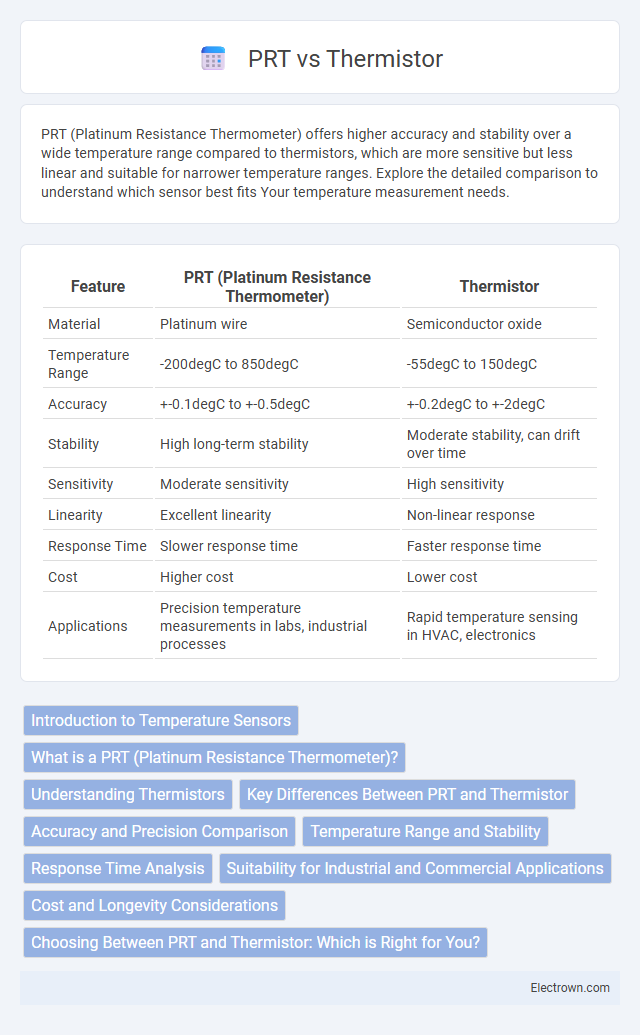PRT (Platinum Resistance Thermometer) offers higher accuracy and stability over a wide temperature range compared to thermistors, which are more sensitive but less linear and suitable for narrower temperature ranges. Explore the detailed comparison to understand which sensor best fits Your temperature measurement needs.
Table of Comparison
| Feature | PRT (Platinum Resistance Thermometer) | Thermistor |
|---|---|---|
| Material | Platinum wire | Semiconductor oxide |
| Temperature Range | -200degC to 850degC | -55degC to 150degC |
| Accuracy | +-0.1degC to +-0.5degC | +-0.2degC to +-2degC |
| Stability | High long-term stability | Moderate stability, can drift over time |
| Sensitivity | Moderate sensitivity | High sensitivity |
| Linearity | Excellent linearity | Non-linear response |
| Response Time | Slower response time | Faster response time |
| Cost | Higher cost | Lower cost |
| Applications | Precision temperature measurements in labs, industrial processes | Rapid temperature sensing in HVAC, electronics |
Introduction to Temperature Sensors
Temperature sensors such as Platinum Resistance Thermometers (PRTs) and thermistors are essential for precise temperature measurement across various industrial and scientific applications. PRTs offer high accuracy and stability over wide temperature ranges due to their linear resistance-temperature relationship, whereas thermistors provide greater sensitivity and faster response times within more limited temperature spans. Selecting between PRTs and thermistors depends on factors like required accuracy, operating environment, and response speed.
What is a PRT (Platinum Resistance Thermometer)?
A PRT (Platinum Resistance Thermometer) is a highly accurate temperature sensor that measures temperature by correlating the resistance of platinum to temperature changes. It provides precise and stable readings over a wide temperature range, making it ideal for industrial and laboratory applications requiring reliable temperature control. Your choice of a PRT ensures consistent thermal measurements due to its excellent repeatability and minimal drift compared to thermistors.
Understanding Thermistors
Thermistors are temperature-sensitive resistors made from semiconductor materials that exhibit a predictable change in resistance with temperature variations. Unlike PRT sensors, thermistors offer higher sensitivity within a limited temperature range, making them ideal for precise temperature measurements in controlled environments. Your choice between PRT and thermistor depends on the required accuracy, temperature range, and response time for your specific application.
Key Differences Between PRT and Thermistor
PRT (Platinum Resistance Thermometer) sensors offer higher accuracy and stability over a wider temperature range (-200degC to 850degC) compared to thermistors, which typically operate effectively between -50degC and 150degC. PRTs exhibit a near-linear resistance-temperature relationship, enhancing precision in industrial and laboratory applications, whereas thermistors have a nonlinear response requiring complex calibration for accurate measurements. PRTs are more robust with excellent long-term stability and repeatability, while thermistors are more cost-effective and suitable for rapid temperature changes in limited range scenarios.
Accuracy and Precision Comparison
Platinum Resistance Thermometers (PRTs) offer superior accuracy and precision compared to thermistors, with measurement uncertainties typically as low as +-0.01degC due to their stable and linear resistance-temperature relationship. Thermistors exhibit higher sensitivity but often have nonlinear responses and greater variability, leading to measurement errors ranging from +-0.1degC to +-0.5degC depending on calibration and type. For critical temperature monitoring requiring high repeatability and minimal drift, PRTs are preferred over thermistors despite their higher cost and slower response time.
Temperature Range and Stability
Platinum Resistance Thermometers (PRTs) offer a wide temperature range from -200degC to 850degC with high stability, making them ideal for precise industrial and laboratory applications. Thermistors typically operate within a narrower temperature range, roughly from -50degC to 150degC, and exhibit less long-term stability due to material aging effects. PRTs maintain consistent resistance characteristics over time, ensuring accurate and reliable measurements in varying environmental conditions.
Response Time Analysis
PRT (Platinum Resistance Thermometer) sensors typically exhibit slower response times ranging from 1 to 10 seconds due to their larger sensing elements and protective sheaths, which add thermal mass and delay heat transfer. Thermistors, composed of semiconductor materials with smaller physical dimensions, offer rapid response times often less than 1 second, making them ideal for applications requiring quick temperature changes detection. The intrinsic thermal inertia of PRTs limits their use in dynamic environments, whereas thermistors excel in scenarios demanding fast, precise temperature monitoring.
Suitability for Industrial and Commercial Applications
PRTs (Platinum Resistance Thermometers) offer high accuracy, stability, and repeatability, making them ideal for industrial and commercial applications requiring precise temperature measurements over a wide range. Thermistors provide faster response times and greater sensitivity at lower temperatures but are less stable and have a limited measurement range, making them better suited for applications with less stringent accuracy demands. Your choice between PRT and thermistor depends on the specific temperature range, accuracy requirements, and environmental conditions of the application.
Cost and Longevity Considerations
PRTs typically have a higher upfront cost than thermistors but offer superior longevity and stability, making them more cost-effective over time in precision applications. Thermistors are less expensive initially, but their shorter lifespan and susceptibility to drift may increase replacement and calibration expenses. You should weigh the balance between initial budget constraints and long-term maintenance costs when selecting between PRTs and thermistors.
Choosing Between PRT and Thermistor: Which is Right for You?
PRT sensors offer superior accuracy and stability over a wide temperature range, making them ideal for precision applications requiring consistent measurements. Thermistors provide faster response times and higher sensitivity at lower costs, suitable for applications where rapid temperature changes must be detected. Your choice between PRT and thermistor depends on the specific requirements for accuracy, temperature range, response time, and budget constraints.
PRT vs Thermistor Infographic

 electrown.com
electrown.com